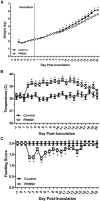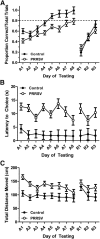Respiratory viral infection in neonatal piglets causes marked microglia activation in the hippocampus and deficits in spatial learning
- PMID: 24501353
- PMCID: PMC3913866
- DOI: 10.1523/JNEUROSCI.2180-13.2014
Respiratory viral infection in neonatal piglets causes marked microglia activation in the hippocampus and deficits in spatial learning
Abstract
Environmental insults during sensitive periods can affect hippocampal development and function, but little is known about peripheral infection, especially in humans and other animals whose brain is gyrencephalic and experiences major perinatal growth. Using a piglet model, the present study showed that inoculation on postnatal day 7 with the porcine reproductive and respiratory syndrome virus (PRRSV) caused microglial activation within the hippocampus with 82% and 43% of isolated microglia being MHC II(+) 13 and 20 d after inoculation, respectively. In control piglets, <5% of microglia isolated from the hippocampus were MHC II(+). PRRSV piglets were febrile (p < 0.0001), anorectic (p < 0.0001), and weighed less at the end of the study (p = 0.002) compared with control piglets. Increased inflammatory gene expression (e.g., IL-1β, IL-6, TNF-α, and IFN-γ) was seen across multiple brain regions, including the hippocampus, whereas reductions in CD200, NGF, and MBP were evident. In a test of spatial learning, PRRSV piglets took longer to acquire the task, had a longer latency to choice, and had a higher total distance moved. Overall, these data demonstrate that viral respiratory infection is associated with a marked increase in activated microglia in the hippocampus, neuroinflammation, and impaired performance in a spatial cognitive task. As respiratory infections are common in human neonates and infants, approaches to regulate microglial cell activity are likely to be important.
Keywords: PRRSV; brain; cognition; inflammation; sickness behavior.
Figures





References
-
- Chen NH, Chen XZ, Hu DM, Yu XL, Wang LL, Han W, Wu JJ, Cao Z, Wang CB, Zhang Q, Wang BY, Tian KG. Rapid differential detection of classical and highly pathogenic North American Porcine Reproductive and Respiratory Syndrome virus in China by a duplex real-time RT-PCR. J Virol Methods. 2009;161:192–198. doi: 10.1016/j.jviromet.2009.06.007. - DOI - PubMed
Publication types
MeSH terms
Grants and funding
LinkOut - more resources
Full Text Sources
Other Literature Sources
Research Materials
Miscellaneous
